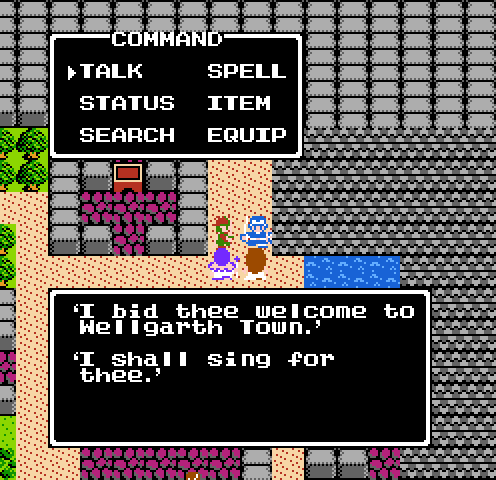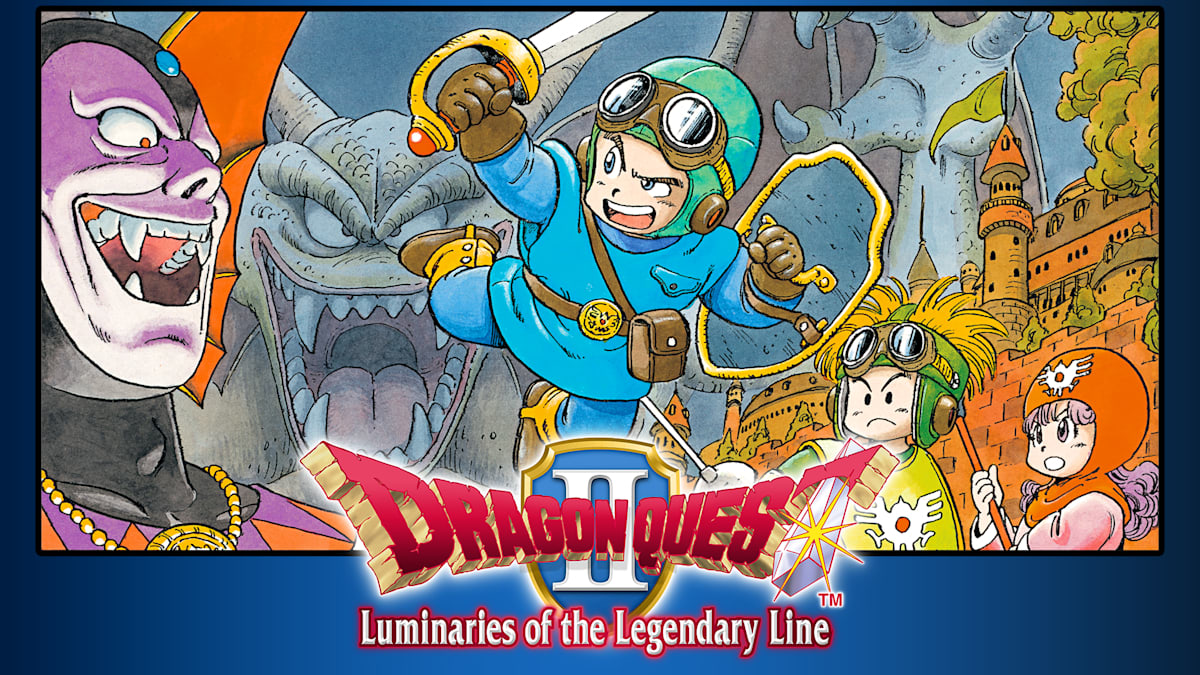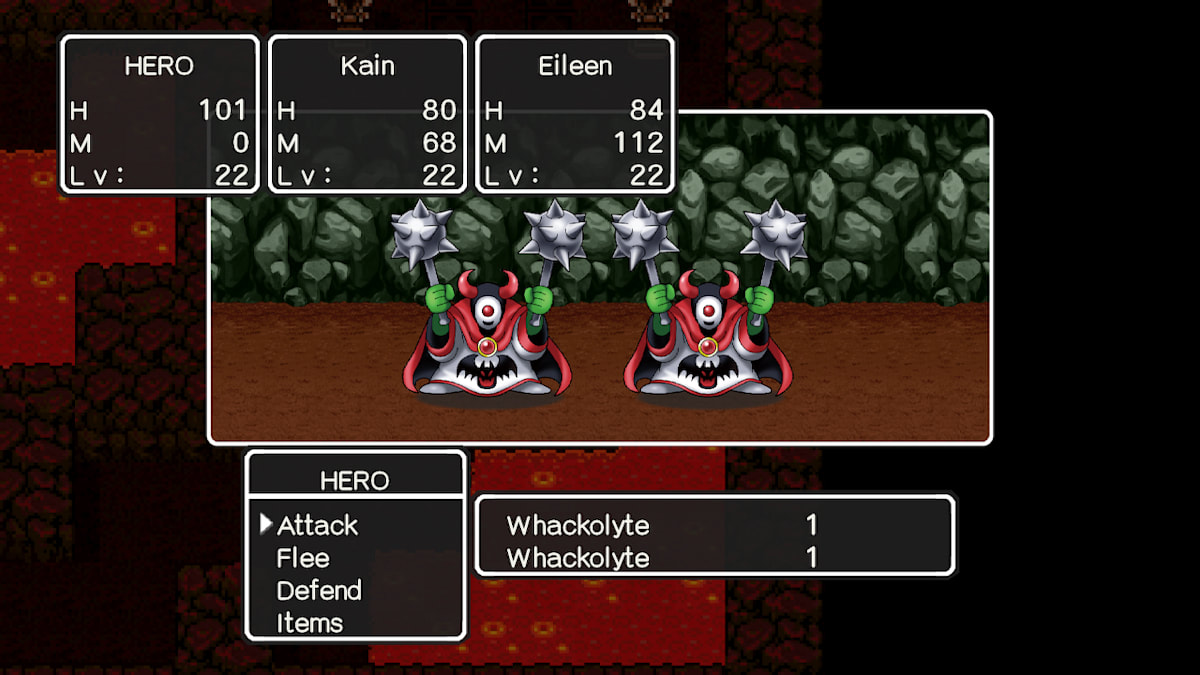Hargon Is Gone (original) (raw)
Having gotten a bit bored of losing to Zeromus in Final Fantasy IV, I decided to do another playthrough of Dragon Quest II, this time on the Switch, which I think is the same version you can get for cell phones. I think it would be weird playing an entire game on my phone, but I guess you take what you can get. It has kind of the same cutesy cartoonish style with disproportionately large heads that I’ve seen pictures of for other phone releases, albeit not to the same extent as what I’ve encountered of the mobile Final Fantasy VI.
I had already played through this game on the NES, when it was Dragon WARRIOR II. That was after I’d played the third game, which was much better realized. The game is known for being unfairly difficult at times, as the programmers didn’t have the time to balance things out properly. There were some clear improvements over DQ1, including a party of three characters. The main character, the Prince of Midenhall, can use a lot of weapons and armor but no magic, while the Prince of Cannock can use a little of both, and the Princess of Moonbrooke just specializes in spells. That said, Cannock can’t really use that many more armaments than Moonbrooke, so they’re both pretty physically weak. There’s a popular meme about Cannock constantly being dead in the NES version, and while I can’t actually recall if he died more than Moonbrooke did in my own experience, it’s quite possible he did because he was attacked more often.
Incidentally, the Switch version calls Cannock an Armamentalist and Moonbrooke a Mage. And there were some monsters toward the end of the game who could wipe out your entire party with one spell that never failed. Later versions of the game were made a bit easier, both in technical matters and in making certain things less frustrating. In the Switch version, the Yggdrasil Leaf brings a character back with full hit points, the Zoom spell lets you choose where to go (in the original it was just the last place you saved the game), and there are indications of where to search for items. I didn’t necessarily need that last one, as I remembered where most things were, but still. The game feels small now, but even when I first played it, the towns and castles seemed a little cramped. This is obviously the case when you revisit Tantegel Castle, which is reduced in size and connected to Brecconary.

Did they physically move one of them? That must have been labor intensive.
But even the new places feel a little on the small side. It does introduce towers and travel by ship. And even in this version, Erdrick’s Sword isn’t very good compared to how it is in DQ1 and 3. Time takes its toll, I suppose.

The plot is about a cult that worships a god of destruction trying to take over the world, with the leader being a priest named Hargon. With Nintendo’s policy of avoiding religious terms, the NES version just called him a wizard. That isn’t entirely wrong, as priests in the series do cast magic spells, but it lacks some nuance. The priests serving him, punningly called Wrecktors and Whackolytes in the modern translation, are instead Mace Masters and Evil Clowns, I guess because the priestly garb looks kind of jesterish.
Maybe it’s like how the chess piece called the bishop in English is a jester in French. On the NES, the Whackolytes refer to themselves as wizards in dialogue, but are Evil Clowns in battle. When these enemies appear in future games, they still wear the bat-like emblems, which are presumably supposed to represent the god Malroth.
And I suppose the false idol that you use to access Rendarak, called the Eye of Malroth on the NES, is an idol of the god.
There is now a mention at the beginning of the game that Hargon wants to summon a dark god, not calling Malroth by name, but still giving more indication of his existence than the game did previously.
That also helps to explain why everyone is so scared of Hargon, aside from his destruction of Moonbrooke Castle. You fight Malroth immediately after defeating Hargon, and I beat him on my second try.
I noticed that some of the lines I best remembered from the NES aren’t in this version, although I suspect the new takes are closer to the original Japanese. I found this script online, so I was able to compare some specifics. There’s a woman in Slewse who complains about her husband sneaking off to get drunk, while the earlier localization instead has them arguing about what to name a dog. That’s funnier, but I suspect it was only put in to remove the reference to alcohol. And a priest in Beran who curses you if you don’t tell him what time it is just says something about Hargon following a false religion.
And a merchant in Zahan who talked about the sunken treasure ship you can find instead reports that the town’s fishermen drowned at sea, perhaps a bit too dark for Nintendo at the time. Or maybe the translator just caught the bit about the sinking boat and assumed it meant something else. Considering how heavy the modern translations are on puns, I’m surprised that they removed one when the King of Moonbrooke, who exists only in the form of a flame, said it was “Hargon’s way of firing those he doesn’t need.” I think this lighthouse keeper’s line was adjusted to work in a reference to the Lord of the Rings films.

I also noticed that someone in Burrowell now explains that the reason everyone is living underground is to get farther away from Hargon’s influence, and there’s a lost guy there named Luke who comes from Zahan. On the other hand, nobody sings to you anymore.
And the Dragonlord’s grandson is now his great-great-grandson, I guess to better fit the hundred years since DQ1.


But dragons live a long time, so I never had a problem with his being a closer descendant than any of the human characters. Since I didn’t die as much this time, I don’t know whether your father still insults you if you die.
With Hargon and Malroth out of the way, I was finally able to beat Zeromus, so I’ll have more on FF4 in the near future. I’m also revisiting the DS version of DQ4 and taking another crack at Psaro, but I think my levels are kind of low.



